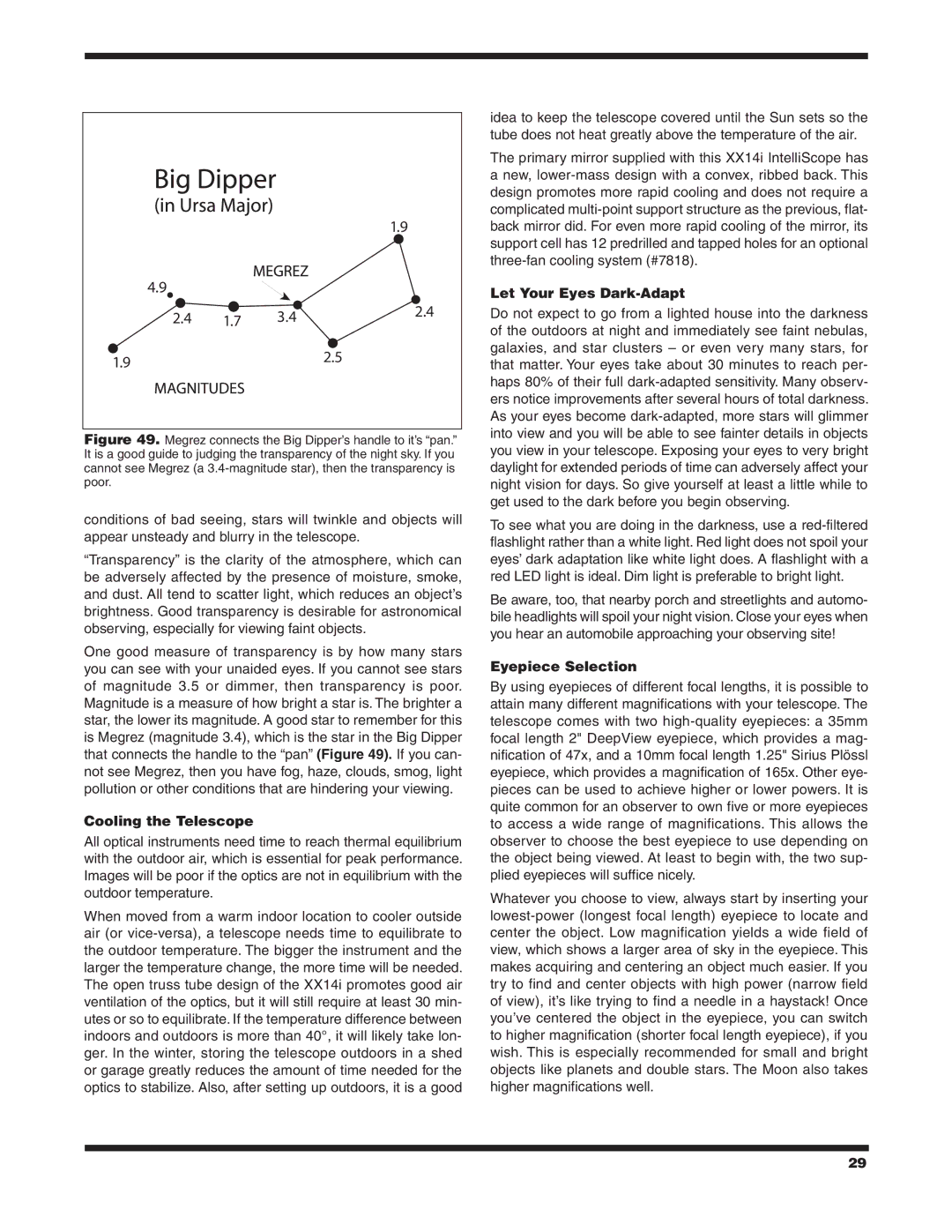| | | 1.9 |
4.9 | | | |
2.4 | 1.7 | 3.4 | 2.4 |
|
1.9 | | | 2.5 |
| | |
Figure 49. Megrez connects the Big Dipper’s handle to it’s “pan.” It is a good guide to judging the transparency of the night sky. If you cannot see Megrez (a 3.4-magnitude star), then the transparency is poor.
conditions of bad seeing, stars will twinkle and objects will appear unsteady and blurry in the telescope.
“Transparency” is the clarity of the atmosphere, which can be adversely affected by the presence of moisture, smoke, and dust. All tend to scatter light, which reduces an object’s brightness. Good transparency is desirable for astronomical observing, especially for viewing faint objects.
One good measure of transparency is by how many stars you can see with your unaided eyes. If you cannot see stars of magnitude 3.5 or dimmer, then transparency is poor. Magnitude is a measure of how bright a star is. The brighter a star, the lower its magnitude. A good star to remember for this is Megrez (magnitude 3.4), which is the star in the Big Dipper that connects the handle to the “pan” (Figure 49). If you can- not see Megrez, then you have fog, haze, clouds, smog, light pollution or other conditions that are hindering your viewing.
Cooling the Telescope
All optical instruments need time to reach thermal equilibrium with the outdoor air, which is essential for peak performance. Images will be poor if the optics are not in equilibrium with the outdoor temperature.
When moved from a warm indoor location to cooler outside air (or vice-versa), a telescope needs time to equilibrate to the outdoor temperature. The bigger the instrument and the larger the temperature change, the more time will be needed. The open truss tube design of the XX14i promotes good air ventilation of the optics, but it will still require at least 30 min- utes or so to equilibrate. If the temperature difference between indoors and outdoors is more than 40°, it will likely take lon- ger. In the winter, storing the telescope outdoors in a shed or garage greatly reduces the amount of time needed for the optics to stabilize. Also, after setting up outdoors, it is a good
idea to keep the telescope covered until the Sun sets so the tube does not heat greatly above the temperature of the air.
The primary mirror supplied with this XX14i IntelliScope has
anew, lower-mass design with a convex, ribbed back. This design promotes more rapid cooling and does not require a complicated multi-point support structure as the previous, flat- back mirror did. For even more rapid cooling of the mirror, its support cell has 12 predrilled and tapped holes for an optional three-fan cooling system (#7818).
Let Your Eyes Dark-Adapt
Do not expect to go from a lighted house into the darkness of the outdoors at night and immediately see faint nebulas, galaxies, and star clusters – or even very many stars, for that matter. Your eyes take about 30 minutes to reach per- haps 80% of their full dark-adapted sensitivity. Many observ- ers notice improvements after several hours of total darkness. As your eyes become dark-adapted, more stars will glimmer into view and you will be able to see fainter details in objects you view in your telescope. Exposing your eyes to very bright daylight for extended periods of time can adversely affect your night vision for days. So give yourself at least a little while to get used to the dark before you begin observing.
To see what you are doing in the darkness, use a red-filtered flashlight rather than a white light. Red light does not spoil your eyes’ dark adaptation like white light does. A flashlight with a red LED light is ideal. Dim light is preferable to bright light.
Be aware, too, that nearby porch and streetlights and automo- bile headlights will spoil your night vision. Close your eyes when you hear an automobile approaching your observing site!
Eyepiece Selection
By using eyepieces of different focal lengths, it is possible to attain many different magnifications with your telescope. The telescope comes with two high-quality eyepieces: a 35mm focal length 2" DeepView eyepiece, which provides a mag- nification of 47x, and a 10mm focal length 1.25" Sirius Plössl eyepiece, which provides a magnification of 165x. Other eye- pieces can be used to achieve higher or lower powers. It is quite common for an observer to own five or more eyepieces to access a wide range of magnifications. This allows the observer to choose the best eyepiece to use depending on the object being viewed. At least to begin with, the two sup- plied eyepieces will suffice nicely.
Whatever you choose to view, always start by inserting your lowest-power (longest focal length) eyepiece to locate and center the object. Low magnification yields a wide field of view, which shows a larger area of sky in the eyepiece. This makes acquiring and centering an object much easier. If you try to find and center objects with high power (narrow field of view), it’s like trying to find a needle in a haystack! Once you’ve centered the object in the eyepiece, you can switch to higher magnification (shorter focal length eyepiece), if you wish. This is especially recommended for small and bright objects like planets and double stars. The Moon also takes higher magnifications well.

